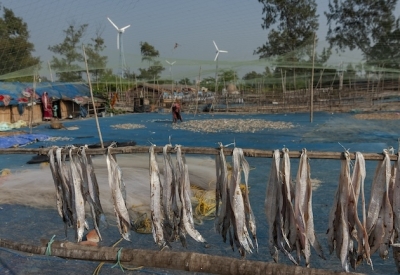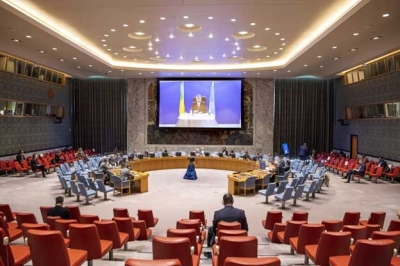Artisanal mining, or "garimpo" as it is known in Brazil, has returned to the headlines as a factor in the deaths of Yanomami indigenous people, whose territory in the extreme north of Brazil suffers constant encroachment by miners, which has intensified in recent years.
In the first few days of the year, Yanomami spokespersons denounced new invasions of their land and the suspension of health services, in addition to the violence committed by miners or "garimpeiros", which coincided with the fact that the military withdrew from areas they were protecting.
Furthermore, the media published new photos of extremely malnourished children. In response, the government promised to establish permanent posts of health care and protection in the indigenous territory.
"But what they are involved in there is not garimpo but illegal and inhumane mining practices," said Gilson Camboim, president of the Peixoto River Valley Garimpeiros Cooperative (Coogavepe), which defends the activity as environmentally and socially sustainable when properly carried out.
"Garimpo is mining recognized by the Brazilian constitution, with its own legislation, which pays taxes, is practiced with an environmental license and respects the laws, employs many workers, strengthens the economy and distributes income," he told IPS by telephone from the headquarters of his cooperative in Peixoto de Azevedo, a town of 33,000 people in the northern state of Mato Grosso.
Coogavepe was founded in 2008 with 23 members. Today it has 7,000 members and seeks to promote legal garimpo and environmental practices, such as the restoration of areas degraded by mining.
But it is difficult to salvage the reputation of this legal part of an activity whose damage is demonstrated by photos of emaciated children and families decimated by hunger and malaria, because the encroachment of miners pollutes rivers, kills fish and introduces diseases to which indigenous people are vulnerable because they have not developed immune defenses.
Garimpeiros and indigenous deaths
The humanitarian tragedy among the Yanomami people became big news in January 2023 when Sumaúma, an Amazonian online media outlet, denounced the deaths of 570 children under five years of age, due to malnutrition and preventable diseases, during the far-right government of former president Jair Bolsonaro (2019-2022).
Luiz Inácio Lula da Silva, who took office on Jan. 1, 2023, visited Yanomami territory and mobilized his government to care for the sick and expel illegal miners, destroying their equipment and camps. But a year later, the resumption of mining activity and a resurgence of hunger and deaths were reported.
Moreover, the entire extractivist sector has a terrible reputation due to tragedies caused by industrial mining. Two tailings dams broke in the southeastern state of Minas Gerais in 2015 and 2019, killing 289 people and muddying an 853-kilometer-long river and a 510-kilometer-long river.
Brazil is the world’s second largest producer of iron ore, following Australia. Iron ore is the main focus of industrial mining in the country.
Garimpo is mainly dedicated to gold, and accounts for 86 percent of its production. Garimpeiros also produce cassiterite (the mineral from which tin ore is extracted) and precious stones, such as emeralds and diamonds. Its major expansion, many decades ago, was along rivers in the Amazon jungle, to the detriment of indigenous peoples and tropical forests.
Threat to the environment and health
Currently, 97.7 percent of the area occupied in Brazil by artisanal mining is in the Amazon rainforest, where it reaches 101,100 hectares, according to MapBiomas, a project launched by non-governmental organizations, universities and technology companies to monitor Brazilian biomes using satellite images and other data sources.
The production of gold uses mercury, which has contaminated many Amazonian rivers and a large part of their riverside population, including indigenous groups, such as the Munduruku people, who live in the basin of the Tapajós River, one of the great tributaries of the Amazon with an extension of 2,700 kilometers.
Garimpo dumps about 150 tons of mercury in the Brazilian Amazon rainforest every year, the World Wildlife Fund (WWF) estimates. The fear is that the tragedy of Minamata, the Japanese city where mercury dumped by a chemical industry in the mid-20th century killed about 900 people and caused neurological damage in tens of thousands, may be repeated here.
Brazil produced 94.6 tons of gold in 2022, according to the National Mining Agency. But the way it is extracted varies greatly, based mainly on informal mining, of which illegal mining makes up an unknown percentage.
Three prices govern this production, according to Armin Mathis, a professor at the Núcleo de Altos Estudos Amazónicos of the Federal University of Pará, who lives in Belém, the capital of this Amazonian state, with 1.3 million inhabitants.
The price of gold in Brazil; the price of diesel, which represents a third of the cost of gold mining; and the cost of labor are the three elements that determine whether the garimpo business is profitable, the German-born PhD in political science, who has been studying this activity since he arrived in Brazil in 1987, explained to IPS from Belém.
This mining was in fact artisanal, but it began to use machines, especially the backhoe, in the 1980s, which is why diesel increased its costs. And unemployment and periods of economic recession, in the 1980s and in 2015-2016, made garimpo more attractive.
In those periods and the following years, invasions of Yanomami territory, which also extends through the state of Amazonas in southwestern Venezuela, became more massive and aggressive. But the consequences for the native people living in vast areas of the rainforest only become news on some occasions, like now.

From artisanal to mechanization
Mechanization has restructured the activity. Machines are expensive and require financiers. Entrepreneurs have emerged to manage the now more complex operations, as well as others who only own and rent out the equipment.
In addition, the owners of small airplanes that supply the mining areas and facilitate the trade of the extracted gold became more powerful. The hierarchy of the business has expanded.
"We must differentiate between garimpo and the garimpeiros. This is not a rhetorical distinction. The garimpeiro, who works directly in the extraction of gold, is more a victim than a perpetrator of illegal, predatory and criminal mining. The person responsible lives far away and gets rich by exploiting workers in slavery-like labor relations," observed Mauricio Torres, a geographer and professor at the Federal University of Pará.
"The garimpeiro, depicted as a criminal by the media, pays for the damage," he told IPS by telephone from Belém.
The workers recognize that they are exploited, but feel that they are a partner of the garimpo owner, as they earn a percentage of the gold obtained. They work hard because the more they work, the more they earn.
A large part of the garimpeiros along the Tapajós River, where this kind of mining has been practiced since the middle of the last century, are actually landless peasant farmers who supplement their income in the garimpo business, when agriculture or fishing does not provide what they need to support their families, Torres explained.
Therefore, agrarian reform and other government initiatives that offer sufficient income to this population could reduce the pressure of the garimpo on the environment in the Amazon rainforest, which affects the region’s indigenous and traditional peoples, he said.
The situation of the garimpeiros also differs according to the areas where they work in the Amazon jungle, Mathis pointed out. In the Tapajós River, where the activity has been taking place for a longer period of time and is already legal in large part, coexistence is better with the indigenous Munduruku people, some of whom also became garimpeiros.
In Roraima, a state in the extreme north on the border with Venezuela and Guyana, where a large part of the territory is made up of indigenous reserves, illegal mining is widespread and includes the more or less violent invasion of Yanomami lands.
On the other hand, as the local economy depends on gold, the population’s support for garimpo, even illegal and more invasive practices, is broader than elsewhere. There, former president Bolsonaro, a supporter of garimpo, won 76 percent of the votes in the 2022 runoff election in which he was defeated by Lula.
Another component that aggravates the violence surrounding garimpo and, therefore, the crackdown on the activity, is the expansion of drug trafficking in the Amazon rainforest. The informality of the mining industry has facilitated its relationship with organized crime, whether in the drug trade or money laundering, said Mathis from Belém.






